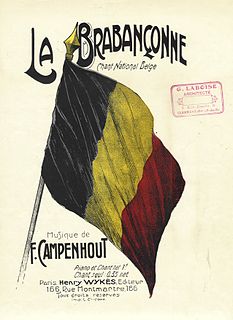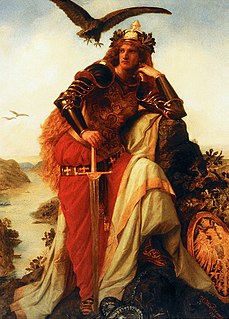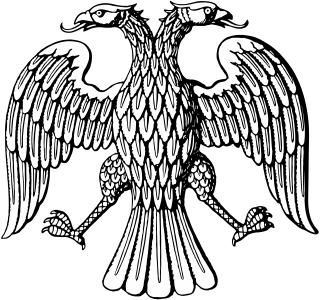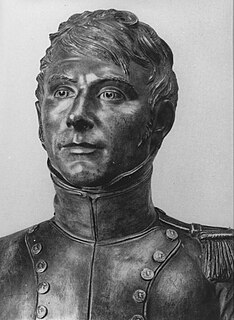
"La Brabançonne" is the national anthem of Belgium. The originally-French title refers to Brabant; the name is usually maintained untranslated in Belgium's other two official languages, Dutch and German.

"La Marseillaise" is the national anthem of France. The song was written in 1792 by Claude Joseph Rouget de Lisle in Strasbourg after the declaration of war by France against Austria, and was originally titled "Chant de guerre pour l'Armée du Rhin".
A national anthem is a patriotic musical composition symbolizing and evoking eulogies of the history and traditions of a country or nation. The majority of national anthems are marches or hymns in style. Latin American, Central Asian, and European nations tend towards more ornate and operatic pieces, while those in the Middle East, Oceania, Africa, and the Caribbean use a more simplistic fanfare. Some countries that are devolved into multiple constituent states have their own official musical compositions for them ; their constituencies' songs are sometimes referred to as national anthems even though they are not sovereign states.

"The Internationale" is a left-wing anthem. It has been a standard of the socialist movement since the late nineteenth century, when the Second International adopted it as its official anthem. The title arises from the "First International", an alliance of workers which held a congress in 1864. The author of the anthem's lyrics, Eugène Pottier, an anarchist, attended this congress. In turn, the song was later set to an original melody composed by Pierre De Geyter, a Marxist.

The Year 1812 Solemn Overture, Op. 49, popularly known as the 1812 Overture, is a concert overture in E♭ major written in 1880 by Russian composer Pyotr Ilyich Tchaikovsky to commemorate the successful Russian defense against Napoleon's invading Grande Armée in 1812.

"Die Wacht am Rhein" is a German patriotic anthem. The song's origins are rooted in the historical French–German enmity, and it was particularly popular in Germany during the Franco-Prussian War and the First World War. The original poem was written by Max Schneckenburger in 1840, and is generally sung to music written by Karl Wilhelm in 1854, seven years after Schneckenburger's death.

Pierre Chrétien De Geyter was a Belgian socialist and a composer, known for writing the music of The Internationale.

The Worker's Marseillaise is a Russian revolutionary song named after the Marseillaise. It is based on a poem of Pyotr Lavrov, first published on 1 July 1875 in London as A new song. The poem reflects a radical socialist program and calls for the violent destruction of the Russian monarchy. At the end of 1875 or in 1876, this poem began to be sung in Russia to the melody of the last verse of the Robert Schumann's song Die beiden grenadiere. Schumann's melody is inspired by the French Marseillaise, but it is original. Thus, the melody and lyrics of the Worker's Marseillaise have nothing to do with the French Marseillaise. The song is close to the Russian cruel romances, and this influenced its popularity. The name the Worker's Marseillaise has been fixed since the 1890s.
"Maréchal, nous voilà !" is a 1941 French song dedicated to Marshal Philippe Pétain. The lyrics were composed by André Montagard and its music was attributed to André Montagard and Charles Courtioux. The song was performed many times like a famous variation by André Dassary and others, and on many official and unofficial occasions in France and its territories during the Vichy France Era.
Marseille is the second-largest city of France.

The French cruiser Marseillaise was one of five Gloire-class armored cruisers built for the French Navy in the first decade of the 20th century. Fitted with a mixed armament of 194-millimeter (7.6 in) and 164.7-millimeter (6.5 in) guns, the ships were designed for service with the battle fleet. Completed in 1903, Marseillaise joined her sister ships in the Northern Squadron. She was transferred to the Mediterranean Squadron the following year where she served as a flagship, but rejoined the Northern Squadron in 1908. Together with two of her sisters, the ship returned to the Mediterranean the following year, but was assigned to the 2nd Squadron in 1911, as the units based in northwestern France had been renamed.

Aux Armes et cætera is the thirteenth studio album by Serge Gainsbourg, released in the early spring of 1979. It was recorded in Kingston, Jamaica, with some of the island's best reggae musicians at the time as well as members of the I Threes, Bob Marley's backup chorus which includes Rita Marley. Further expanded by new mixes, dubs and Jamaican versions released in 2003 and 2015, the album is considered by many as being one of his masterpieces. The French edition of Rolling Stone magazine named this album the 50th greatest French rock album. The recording marked the first time a white singer had recorded a full reggae-influenced album in Jamaica, following previous single-song recordings from Paul Simon and Peter Tosh and Mick Jagger.

"The March of the Women" is a song composed by Ethel Smyth in 1910, to words by Cicely Hamilton. It became the official anthem of the Women's Social and Political Union (WSPU) and more widely the anthem of the women's suffrage movement throughout the United Kingdom and elsewhere. Activists sang it not only at rallies but also in prison while they were on hunger strike. Smyth produced a number of different arrangements of the work.
La Marseillaise is a French film of 1938, directed by Jean Renoir. A vast political, social, and military panorama of the French Revolution up to the autumn of 1792, its many episodes range from the life of ordinary working people through the committed bourgeois struggling for change up to those in the upper echelons of society defending the status quo.

François Mireur was a French general who is notable for having sung the "War Song for the Army of the Rhine", later known as La Marseillaise, in 1792 when he volunteered for the newly created republican army. He later served under Napoleon Bonaparte and was killed in Egypt in 1798.

"Gernikako Arbola" is the title of a song in bertso form presented both in Madrid (1853) and by the shrine of Saint Anthony at Urkiola (1854) by the Basque bard José María Iparraguirre, celebrating the Tree of Gernika and the Basque liberties. The song is an unofficial anthem of the Basques, besides the "Eusko Abendaren Ereserkia", a largely instrumental version used for official purposes in the Basque Autonomous Community. In 2007, as set out by the 4/2007 Chartered Decision, the General Assembly of Biscay declared it the district's official anthem.
André Montagard was a French songwriter and poet. He wrote the lyrics to several songs, including Maréchal, nous voilà !, one of two national anthems during Vichy France. He published four poetry collections about Provence in the 1950s and 1960s.
"The Women's Marseillaise" was the former Women's Social and Political Union (WSPU) official anthem. It was sung to the tune of La Marseillaise and included words about women's suffrage written by Florence MacAulay. The song was sung by suffragists in both the United Kingdom and the United States.
La Marseillaise is an office skyscraper in the Euroméditerranée, Marseille, France. It is part of Les Quais d'Arenc development complex and located near the CMA CGM Tower, the city's tallest building. It has 31 floors with an overall height of 135 m (443 ft). The building construction started in 2015 and finished in 2018. It was developed by Constructa Urban Systems and designed by Ateliers Jean Nouvel. It is known for its innovative tricolor facade design and ranked second in 2018 Emporis Skyscraper Award.











